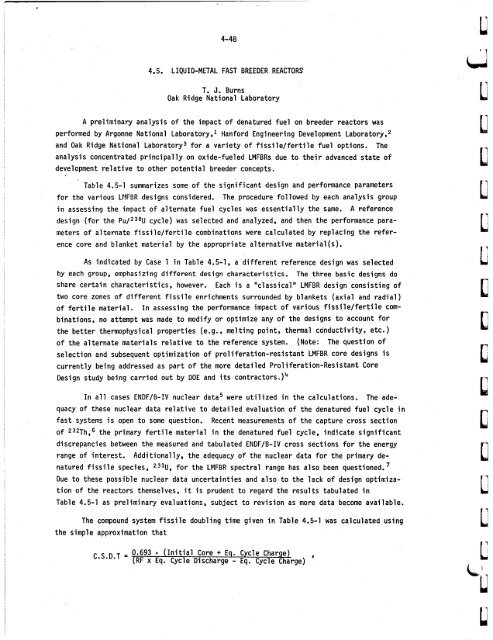ORNL-5388 - the Molten Salt Energy Technologies Web Site
ORNL-5388 - the Molten Salt Energy Technologies Web Site
ORNL-5388 - the Molten Salt Energy Technologies Web Site
You also want an ePaper? Increase the reach of your titles
YUMPU automatically turns print PDFs into web optimized ePapers that Google loves.
4-48<br />
4.5. LIQUID-METAL FAST BREEDER REACTORS<br />
T. J. Burns<br />
Oak Ridge National Laboratory<br />
A preliminary analysis of <strong>the</strong> impact of denatured fuel on breeder reactors was<br />
performed by Argonne National Laboratory, Hanford Engineering Development Laboratory,2<br />
and Oak Ridge National Laboratory3 for a variety of fissile/fertile fuel options.<br />
analysis concentrated principally on oxide-fueled LMFBRs due to <strong>the</strong>ir advanced state of<br />
development relative to o<strong>the</strong>r potential breeder concepts.<br />
Table 4.5-1 summarizes some of <strong>the</strong> significant design and performance parameters<br />
for <strong>the</strong> various LMFBR designs considered. The procedure followed by each analysis group<br />
in assessing <strong>the</strong> impact of alternate fuel cycles was essentially <strong>the</strong> same.<br />
The<br />
A reference<br />
design (for <strong>the</strong> Pu/~~*U cycle) was selected and analyzed, and <strong>the</strong>n <strong>the</strong> performance para-<br />
meters of alternate fissile/fertile combinations were calculated by replacing <strong>the</strong> refer-<br />
ence core and blanket material by <strong>the</strong> appropriate alternative material (s).<br />
As indicated by Case 1 in Table 4.5-1, a different reference design was selected<br />
by each group, emphasizing different design characteristics. The three basic designs do<br />
share certain characteristics, however. Each is a "classical" LMFBR design consisting of<br />
two core zones of different fissile enrichments surrounded by blankets (axial and radial)<br />
of fertile material. In assessing <strong>the</strong> performance impact of various fissile/fertile com-<br />
binations, no attempt was made to modify or optimize any of <strong>the</strong> designs to account for<br />
<strong>the</strong> better <strong>the</strong>rmophysical properties (e.g., me1 ting point, <strong>the</strong>rmal conductivity, etc.)<br />
of <strong>the</strong> alternate materials relative to <strong>the</strong> reference system. (Note: The question of<br />
selection and subsequent optimization of proliferation-resistant LMFBR core designs is<br />
currently being addressed as part of <strong>the</strong> more detailed Proliferation-Resistant Core<br />
Design study being carried out by DOE and its contractor^.)^<br />
In all cases ENDF/B-IV nuclear data5 were utilized in <strong>the</strong> calculations. The ade-<br />
quacy of <strong>the</strong>se nuclear data relative to detailed evaluation of <strong>the</strong> denatured fuel cycle<br />
fast systems is open to some question. Recent measurements of <strong>the</strong> capture cross section<br />
of 232Th,6 <strong>the</strong> primary fertile material in <strong>the</strong> denatured fuel cycle, indicate significan<br />
discrepancies between <strong>the</strong> measured and tabulated ENDF/B-IV cross sections for <strong>the</strong> energy<br />
range of interest. Additionally, <strong>the</strong> adequacy of <strong>the</strong> nuclear data for <strong>the</strong> primary de-<br />
natured fissile species, 233U, for <strong>the</strong> LMFBR spectral range has also been questioned.'<br />
Due to <strong>the</strong>se possible nuclear data uncertainties and also to <strong>the</strong> lack of design optimiza-<br />
tion of <strong>the</strong> reactors <strong>the</strong>mselves, it is prudent to regard <strong>the</strong> results tabulated in<br />
Table 4.5-1 as preliminary evaluations, subject to revision as more data become available.<br />
The compound system fissile doubling time given in Table 4.5-1 was calculated using<br />
<strong>the</strong> simple approximation that<br />
C.S.D.T =<br />
0.693 s (Initial Core + Eq. Cycle Charge)<br />
(RF x Eq. Cycle Discharge - Eq. Cycle Charge) '<br />
n<br />
L;<br />
I:



![Review of Molten Salt Reactor Physics Calculations [Disc 2]](https://img.yumpu.com/21979492/1/190x247/review-of-molten-salt-reactor-physics-calculations-disc-2.jpg?quality=85)












